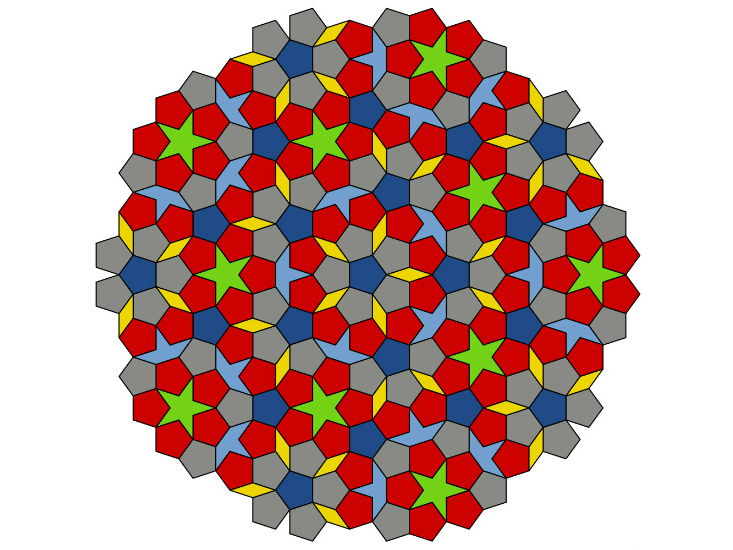
Back in June, researchers at Ames laboratory in Iowa announced the discovery a new group of rare-earth quasicrystals—an unusual class of crystalline materials where the atomic structure boasts regular patterns that never repeat themselves. They resemble the intricate mosaic tiles found in medieval Islamic structures, and technically fall somewhere between a crystal and a glass. This latest work was featured prominently in the prominent journal Nature Materials—deservedly so—but barely made a blip on the general media landscape at large. It just didn’t seem like Big News.
By now, you see, quasicrystals are almost commonplace, with over 100 varieties regularly synthesized in the laboratory and used in surgical instruments, LED lights, and non-stick frying pans (they are excellent insulators because they exhibit such poor heat conductivity). But there was a time when their existence was considered so unlikely that the man who discovered them, Israeli physicist Daniel Schechtman, was roundly mocked by colleagues for his ideas, and was even asked to leave his research group at the Technion-Israel Institute of Technology.
That’s because such an arrangement of atoms was considered impossible until the 1980s. The very definition of a crystal assumes a precisely symmetrical ordering of atoms in periodic patterns that repeat over and over in a three-dimensional lattice. Quasicrystals, in contrast, clearly follow mathematical rules, but each cell has a slightly different configuration of cells nearby, rather than repeating in an identical pattern. And that unusual structure gives quasicrystals some pretty unusual properties.
On April 8, 1982, Schechtman was on peering through an electron microscope at a crystalline sample (an aluminum-manganese alloy), and noticed that the atoms were arranged in strange, aperiodic patterns. This should not have been possible. One good analogy would be trying to tile a bathroom floor: The tiles can only be in certain symmetrical shapes (triangles, squares, or hexagons) if they are going to fit together without leaving any gaps or overlapping. Pentagons, with their fivefold symmetries, just won’t work—except in the case of quasicrystals, nature decided they could work. You just need to fill the gaps with other kinds of atomic shapes to glue the whole thing together.
Even Schechtman didn’t believe his own eyes at first. He duly recorded his observation in his lab notebook with three question marks next to the notation, and purportedly muttered to himself in Hebrew, “Eyn chaya kazo” (“there can be no such creature”). Despite the pushback from colleagues, he persevered, and his discovery eventually appeared in Physical Review Letters. Two decades later, that paper was one of the 10 most cited in the journal’s history, sparking a revolution in crystallography. Eventually scientists figured out how to grow quasicrystals in the laboratory, and the rest is history. Schechtman won the 2011 Nobel Prize in Chemistry for his discovery.
He recorded the observation in his lab notebook with three question marks and purportedly muttered to himself in Hebrew, “Eyn chaya kazo” (“there can be no such creature”).
It wasn’t until 2010 that someone found a naturally occurring quasicrystal, in rock collected from deep in the Koryak mountains of Russia. That person was physicist Paul Steinhardt, who started his search in 1984, combing through various museum collections of rocks for evidence of that telltale aperiodic structure. In 2007, he finally found such a specimen in a collection belonging to Luca Bindi of the University of Florence. Based on the results of his mass spectrometry analysis, he concluded that the sample must have come from a meteorite that fell to Earth.
It was an intriguing, if unlikely, hypothesis, but Steinhardt needed proof that sample was, indeed, from the Koryak mountains. His quest apparently involved “secret diaries, smugglers, gold prospectors, and bears,” among other plot twists that have yet to be laid bare, but eventually he located the man who originally found the sample back in 1979: Valery Kryachko (who had actually been panning for platinum, but came up empty-handed on that score).
Where there’s one naturally occurring quasicrystal, surely there must be others, right? That was Steinhardt’s reasoning, and he formed an expedition into the Russian mountains, with Kryachko as a guide, crawling across the frozen tundra in a couple of tractor vehicles. It was worth the effort: They indeed found more samples containing quasicrystals. And since the area didn’t have the kind of extreme conditions that would have been required to produce them terrestrially, Steinhardt argued that this supported his hypothesis that the quasicrystals came from outer space. He pegged the likely date of impact at around 15,000 years ago, based on local sediment samples.
In fact, Steinhardt thinks that far from being rare and exotic, quasicrystals may have been one of the first minerals to form in the solar system. It’s a reminder that what is common and what is unlikely has so much to do with context, even for things that are as solid as stone.
Jennifer Ouellette is a science writer and the author of The Calculus Diaries and the forthcoming Me, Myself and Why: Searching for the Science of Self. Follow her on Twitter @JenLucPiquant.


























